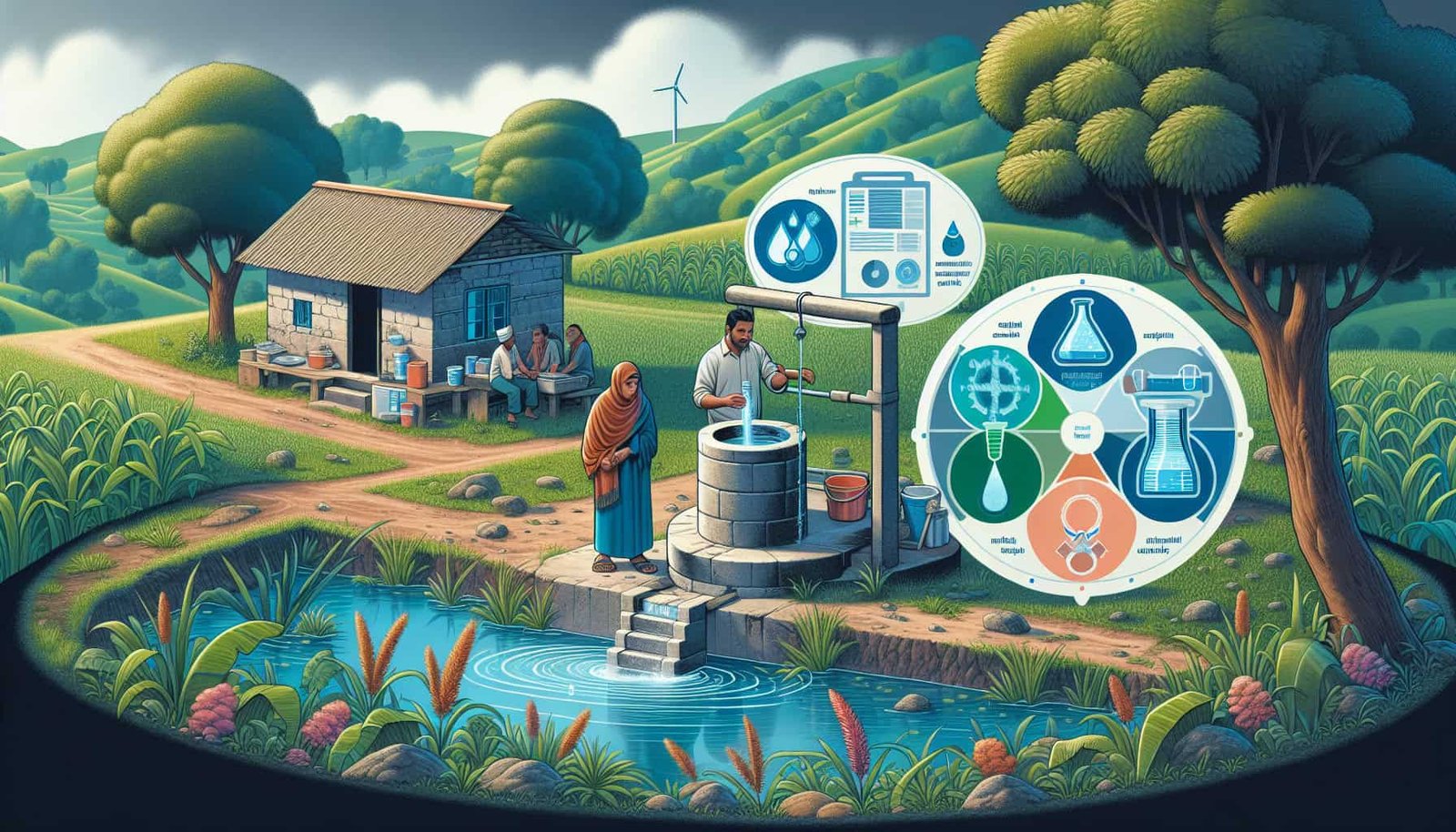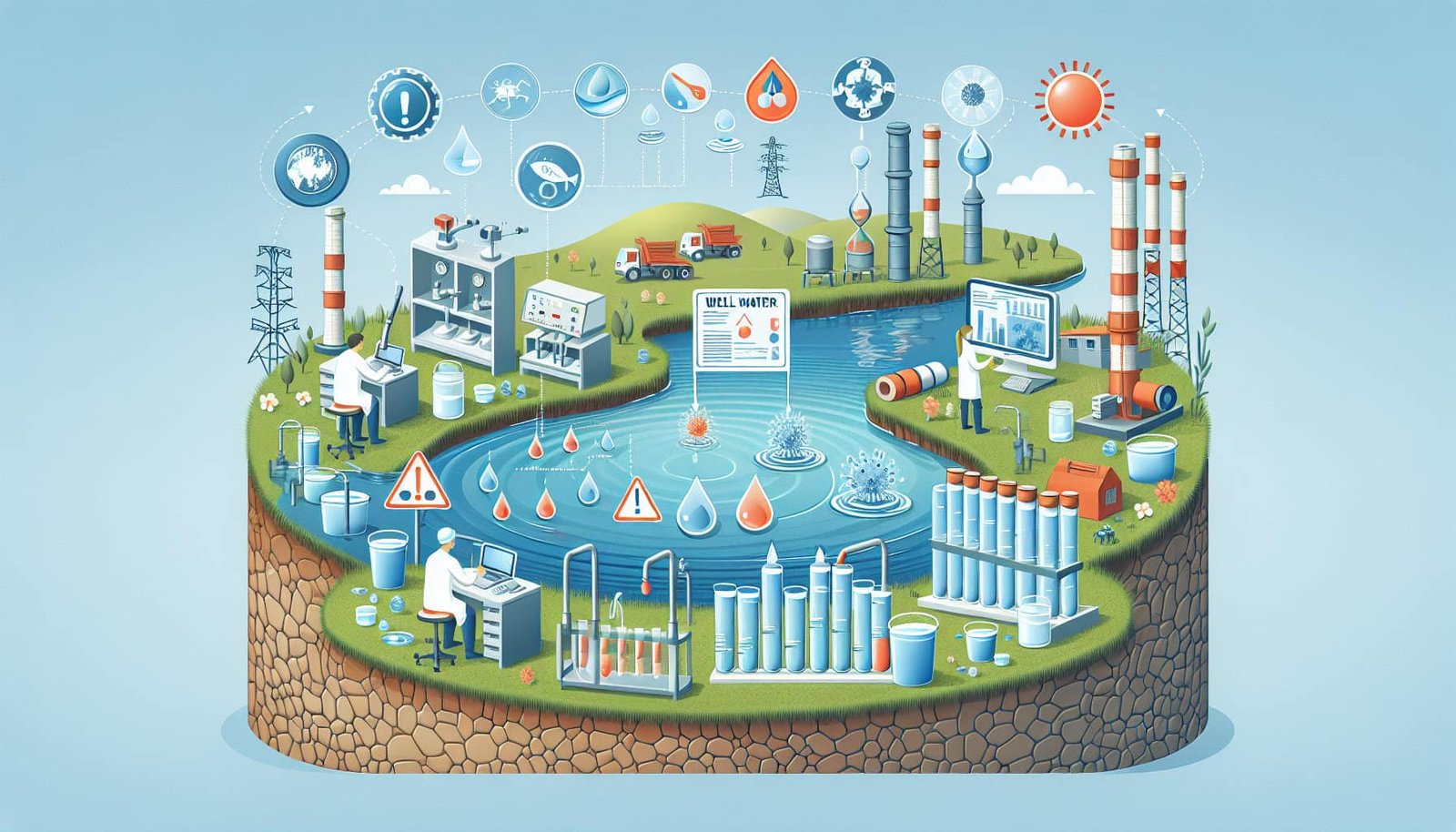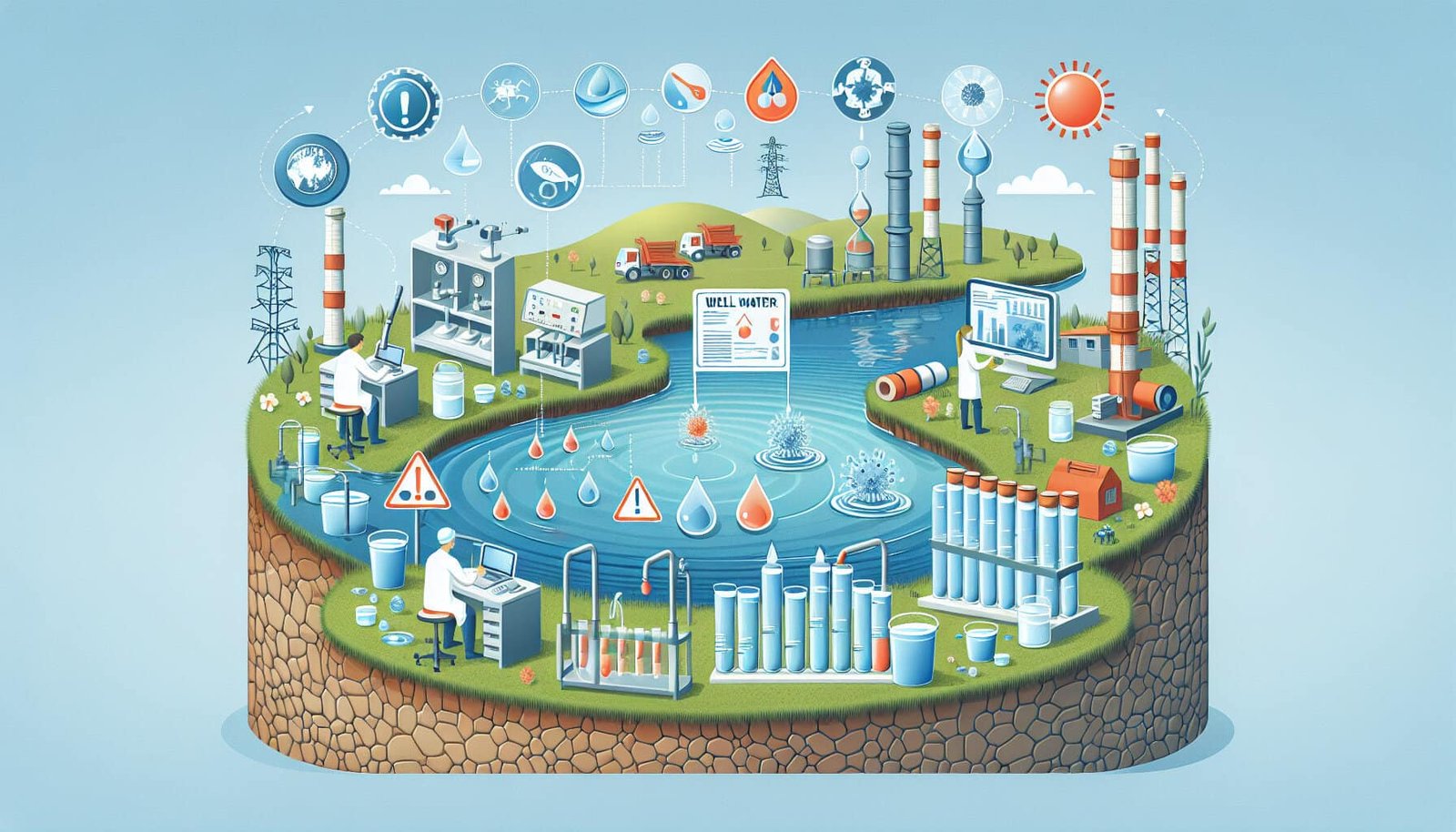Are you unsure about the safety of the well water in your area, even with well water quality testing in place? If you find yourself questioning the reliability of the results or still concerned about potential contaminants, it’s important to know how to address these worries effectively. By taking certain measures and understanding the process of well water quality testing, you can ensure the safety and purity of the water you use on a daily basis. Let’s explore some practical ways for you to address these safety concerns and gain peace of mind in regions with well water quality testing.

Understanding Well Water Quality Testing
What is well water quality testing?
Well water quality testing refers to the process of analyzing and evaluating the physical, chemical, and microbiological characteristics of well water. It involves conducting tests to assess the presence of contaminants, such as bacteria, heavy metals, pesticides, and other harmful substances that may pose a risk to human health. Well water quality testing provides valuable information about the safety and suitability of well water for drinking, cooking, and other domestic uses.
Why is well water quality testing important?
Well water quality testing is essential for ensuring the health and safety of individuals who rely on well water as their primary source of drinking water. Unlike public water systems, which are regulated and regularly tested, private wells are the responsibility of the owners. Testing the well water helps to identify potential contaminants and assess the overall quality of the water supply. Early detection of contaminants allows well owners to take necessary actions to address any issues and protect their health and the health of their families.
How does well water quality testing work?
Well water quality testing typically involves collecting water samples from the well and sending them to a certified laboratory for analysis. The laboratory utilizes various testing methods to evaluate the water samples for different parameters, including pH levels, dissolved solids, bacteria, heavy metals, and chemical contaminants. The test results provide information about the concentration of contaminants and whether they exceed the maximum allowable limits set by regulatory authorities. These results help in determining the overall quality of the well water and identifying any necessary actions to improve its safety.
Identifying Potential Contaminants in Well Water
Common contaminants found in well water
Well water can be susceptible to various contaminants, both naturally occurring and human-made. Some of the common contaminants found in well water include:
- Bacteria and other microorganisms
- Nitrates and nitrites
- Arsenic
- Lead
- Pesticides and herbicides
- Volatile organic compounds (VOCs)
- Radon
- Iron and manganese
It is important to note that the presence of contaminants can vary depending on the geographic location and surrounding land use activities. Therefore, it is crucial to conduct regular well water quality testing to identify specific contaminants that may be present in your well water.
External factors that can contaminate well water
Well water can be susceptible to contamination due to various external factors, including:
- Nearby agriculture or industrial activities that use fertilizers, pesticides, or toxic substances
- Improperly constructed or maintained wells that allow surface water or groundwater to enter the well
- Leaking underground storage tanks
- Improper disposal of hazardous substances
- Sewage system failures or leaks
- Natural geological formations that release contaminants into groundwater
Understanding these external factors can help identify potential sources of contamination and take preventive measures to safeguard your well water.
Health risks associated with these contaminants
Exposure to contaminated well water can pose significant health risks. The specific health effects depend on the type and concentration of the contaminants. Some of the health risks associated with common contaminants found in well water include:
- Bacterial contamination can lead to gastrointestinal illnesses, such as diarrhea, vomiting, and stomach cramps.
- High levels of nitrates can cause methemoglobinemia, a condition commonly known as “blue baby syndrome,” which affects the ability of blood to transport oxygen.
- Arsenic exposure is associated with various health problems, including skin lesions, cardiovascular diseases, and an increased risk of certain cancers.
- Lead exposure can lead to developmental delays in children, lowered IQ, and an increased risk of high blood pressure and kidney damage.
- Pesticides and herbicides have been linked to reproductive and developmental issues, hormonal imbalances, and an increased risk of certain cancers.
Identifying and addressing these contaminants is crucial to prevent potential health hazards and ensure the well water is safe for consumption.
Interpreting Well Water Test Results
Understanding the different parameters measured in well water
Well water testing involves measuring various parameters to assess the quality of the water. Some of the key parameters measured in well water testing include:
- pH level: Indicates the acidity or alkalinity of the water.
- Total dissolved solids (TDS): Refers to the concentration of dissolved substances in the water.
- Bacteria: Determines the presence of coliform bacteria, E. coli, and other harmful microorganisms.
- Heavy metals: Includes testing for contaminants like lead, arsenic, iron, and manganese.
- Nitrates and nitrites: Measures the concentration of these compounds, which can come from fertilizers and other sources.
- Pesticides and herbicides: Identifies the presence of these chemicals, which can leach into the groundwater.
- Volatile organic compounds (VOCs): Determines the presence of potentially harmful chemicals, such as solvents and fuels.
These parameters provide insights into the overall quality of the well water and its suitability for various uses.
Types of tests performed in well water quality testing
Different types of tests are conducted in well water quality testing to assess specific contaminants. These tests include:
- Bacterial tests: Detect the presence of harmful bacteria like E. coli and coliforms.
- Chemical tests: Measure the concentration of specific chemicals, such as heavy metals, nitrates, pesticides, and VOCs.
- Physical tests: Evaluate characteristics like pH level, temperature, odor, and taste.
- Radiological tests: Determine the presence of radioactive elements like radon.
Based on the intended use of the well water and specific concerns, a combination of these tests may be conducted to obtain a comprehensive understanding of the water quality.
Interpreting test results and understanding what they mean
Interpreting well water test results can be complex, as it requires understanding the specific parameters measured and the corresponding regulatory standards. Water testing laboratories typically provide detailed reports that indicate the concentration of contaminants found in the water sample and whether they exceed regulatory limits. It is crucial to compare the test results with the local, state, or national standards to determine the safety of the well water.
If the test results indicate the presence of contaminants exceeding the allowable limits, it is essential to take appropriate actions to address the issue. This may involve implementing treatment measures, seeking professional advice, or, in severe cases, finding alternative water sources. Consulting with water testing professionals or local health departments can provide valuable guidance on the best course of action based on the specific test results.
Actions to Improve Well Water Quality
Implementing regular well maintenance and inspections
Regular maintenance and inspections of the well system are essential for ensuring the longevity and safety of the well water. Some key actions to consider include:
- Periodically inspecting the well for any signs of damage or deterioration.
- Maintaining proper well construction to prevent surface water infiltration.
- Ensuring proper well sealing and casing to prevent contamination.
- Regularly inspecting and maintaining well equipment, such as pumps, pipes, and pressure tanks.
- Conducting regular well cleanings to remove sediment and potential sources of contamination.
By implementing these maintenance practices, well owners can minimize the risk of contamination and ensure the overall quality of the well water.
Treating well water to remove contaminants
In cases where well water testing identifies specific contaminants exceeding the allowable limits, implementing treatment measures can help improve the water quality. The appropriate treatment method depends on the type and concentration of contaminants present. Common treatment options include:
- Filtration systems: Remove sediment, bacteria, and other particles through physical filtration.
- Disinfection methods: Treat the water with chlorine, ultraviolet (UV) light, or ozone to eliminate harmful microorganisms.
- Reverse osmosis systems: Remove dissolved contaminants, including nitrates, arsenic, and heavy metals, through a semi-permeable membrane.
- Water softeners: Remove excess minerals like calcium and magnesium that cause hardness in the water.
It is crucial to consult with water treatment professionals or certified laboratories to determine the most suitable treatment method based on the specific contaminants identified in the well water.
Alternative sources of water for drinking and cooking
In some cases, despite treatment efforts, certain contaminants may persist in the well water. In such situations, considering alternative sources of water for drinking and cooking is advisable. This can include installing point-of-use water filtration systems, using bottled water, or utilizing water delivery services to ensure access to safe drinking water. Exploring these alternatives can provide peace of mind and protect the well owner’s health.

Addressing Specific Concerns in Well Water Safety
Bacterial contamination and disinfection methods
Bacterial contamination is a common concern in well water safety. Disinfection methods, such as chlorination, ultraviolet (UV) disinfection, and ozonation, can effectively eliminate harmful bacteria and ensure the safety of the water. It is essential to regularly test for bacteria and monitor disinfection systems to ensure their effectiveness.
Arsenic contamination and mitigation strategies
Arsenic contamination in well water can be a significant health concern. Mitigation strategies for arsenic contamination include the installation of point-of-entry treatment systems, such as adsorption or ion exchange systems, that effectively remove arsenic from the water. Regular testing and monitoring are essential to ensure the efficacy of these mitigation strategies.
Nitrates in well water and reducing their presence
High levels of nitrates in well water, often originating from agricultural activities or septic systems, can pose health risks, especially to infants and pregnant women. To reduce the presence of nitrates, implementing practices such as proper fertilizer use, maintaining adequate setbacks between wells and potential sources of contamination, and employing treatment methods like reverse osmosis can help ensure the water safety.
Understanding the Role of Local Authorities and Regulations
Regulatory bodies overseeing well water quality
Various regulatory bodies on the local, state, and national levels oversee well water quality. These bodies establish guidelines, standards, and guidelines to ensure the safety and quality of well water. Examples of regulatory bodies in the United States include the Environmental Protection Agency (EPA), the Department of Health and Human Services (DHHS), and state health departments.
The legal requirements for well water testing
Legal requirements for well water testing vary by jurisdiction. Some areas have specific regulations mandating regular testing and maintenance of private wells, while others rely on guidelines and recommendations. It is important for well owners to familiarize themselves with the specific legal requirements applicable to their region to ensure compliance with the law and maintain the safety of their well water.
Role of local health departments in addressing safety concerns
Local health departments play a vital role in addressing safety concerns related to well water. They provide information and resources on well water quality testing, educate the community about potential contaminants and health effects, and offer guidance on appropriate actions to address any identified issues. Well owners can reach out to their local health departments for assistance, support, and additional information on well water safety.

Educating the Community on Well Water Safety
Providing information on well water testing and importance
Educating the community about well water testing and its importance is crucial for promoting awareness and ensuring the safety of well water. Public education efforts can include:
- Distributing informational pamphlets or brochures about well water testing and safety measures.
- Organizing community workshops or seminars on well water quality and contamination prevention.
- Creating educational campaigns via local media platforms to reach a wider audience.
By providing accurate and accessible information, well owners and community members can make informed decisions and take necessary actions to protect their well water.
Educating about potential contaminants and their health effects
Raising awareness about potential contaminants in well water and their health effects is essential for promoting well water safety. Educating the community about the health risks associated with contaminants like bacteria, nitrates, arsenic, and other substances can encourage well owners to take proactive measures to protect their water supply. This information can be shared through community health fairs, online resources, and collaborations with local health and environmental organizations.
Promoting safe practices for well water usage
Promoting safe practices for well water usage is crucial in maintaining its quality and preventing contamination. These practices can include:
- Properly disposing of hazardous substances to prevent groundwater pollution.
- Regularly testing well water to identify and address any issues promptly.
- Implementing best practices for well maintenance and inspecting the well system regularly.
- Cautiously using pesticides and fertilizers to minimize their impact on groundwater.
- Engaging in proper well construction and sealing to prevent surface water infiltration.
Community-wide initiatives, such as workshops, orientations, and educational materials, can effectively promote these safe practices and ensure the long-term safety of well water.
Addressing Concerns of Well Owners
Common concerns of well owners regarding water safety
Well owners often have various concerns regarding the safety of their well water. These concerns may include:
- Contamination from nearby agricultural or industrial activities.
- Health risks associated with specific contaminants.
- The effectiveness of treatment methods.
- Compliance with legal regulations.
- Maintaining the overall quality of the well water.
Addressing these concerns and providing solutions can alleviate the worries of well owners and empower them to take appropriate actions to ensure the safety of their well water.
Resources and support available for well owners
Well owners have access to various resources and support to address their concerns and ensure the safety of their well water. These resources include:
- Water testing laboratories: Certified laboratories can conduct well water testing, provide accurate results, and offer guidance on treatment measures.
- Extension services: Agricultural extension offices and local cooperative extension services often provide educational programs and resources on well water safety and treatment.
- Local health departments: Contacting your local health department can provide access to resources, information on regulations, and guidance on addressing well water concerns.
- Professional associations and organizations: Well owner associations and environmental organizations may offer support, education, and advocacy related to well water quality.
By utilizing these resources and seeking support, well owners can address their concerns effectively and make informed decisions regarding their well water safety.
Troubleshooting well water quality issues
In cases where well water quality issues persist or additional concerns arise, troubleshooting the problem becomes necessary. Consulting with water testing professionals, well contractors, or local health departments can help identify the root cause of the issue and determine the most appropriate course of action. These experts can evaluate the well system, conduct additional tests, and provide guidance on addressing specific well water quality issues.

Collaborating with Water Testing Professionals
Choosing a reputable water testing laboratory
When selecting a water testing laboratory, it is important to choose a reputable and certified facility. Consider the following factors:
- Accreditation: Ensure the laboratory is accredited by recognized organizations, such as the National Environmental Laboratory Accreditation Program (NELAP) or the International Organization for Standardization (ISO).
- Testing methods: Verify that the laboratory utilizes appropriate testing methods for the specific contaminants relevant to your location and concerns.
- Turnaround time and reporting: Assess the laboratory’s ability to provide timely results and comprehensive reports that are easy to understand.
- Cost: Consider the cost of testing and any additional fees associated with the laboratory’s services.
By partnering with a reputable laboratory, well owners can have confidence in the accuracy and reliability of their well water test results.
Understanding the costs and process of testing
Water testing costs can vary depending on the number and type of contaminants being tested and the specific laboratory chosen. It is essential to inquire about the cost structure and any additional fees before initiating the testing process. Well owners should also understand the process of sample collection, preservation, and shipment to ensure the integrity of the samples and the accuracy of the test results. The laboratory should provide clear instructions and guidelines for collecting and submitting water samples.
Seeking advice and guidance from experts
Water testing professionals, such as laboratory technicians or environmental specialists, can provide valuable advice and guidance throughout the well water testing process. They can help interpret test results, recommend appropriate treatment options, and address any concerns or questions regarding well water safety. Consulting these experts can provide well owners with the necessary support and expertise to make informed decisions about their well water.
Continuous Monitoring and Maintenance of Well Water Quality
Importance of regular monitoring and follow-up testing
Regular monitoring and follow-up testing are essential to ensure the ongoing safety of well water. Monitoring well water quality helps identify any changes or trends over time, allowing for prompt action if contamination occurs. It is recommended to conduct annual water testing as a baseline and perform additional tests if any changes are observed in the water’s appearance, taste, or odor, or if there are reports of health issues related to water consumption.
Maintaining well infrastructure to ensure water safety
Proper maintenance of the well infrastructure is crucial to ensure the continuous delivery of safe and high-quality water. Key maintenance practices include:
- Regularly inspecting and sealing any openings, cracks, or gaps.
- Maintaining a proper distance between the well and potential sources of contamination.
- Conducting routine checks on well equipment, including pumps, pressure tanks, and pipes.
- Regularly cleaning the well to remove sediment and potential sources of contamination.
By maintaining the well infrastructure, well owners can minimize the risk of contamination and help preserve the quality of their well water.
Recognizing signs of deteriorating well water quality
It is important for well owners to be aware of signs indicating deteriorating well water quality. These signs may include:
- Changes in the water’s appearance, such as cloudiness, discoloration, or the presence of floating particles.
- Foul odors or unpleasant tastes in the water.
- Corrosion or discoloration of plumbing fixtures.
- Health issues reported by individuals consuming the well water.
Recognizing these signs and promptly addressing any changes can help prevent potential health risks associated with deteriorating well water quality.
In conclusion, understanding well water quality testing is essential for well owners to ensure the safety of their water supply. By identifying potential contaminants, interpreting test results, taking necessary actions, and collaborating with professionals, well owners can address safety concerns and maintain the quality of their well water. Continuous monitoring and maintenance are key to ensuring long-term water safety and the well-being of those relying on well water as their primary source.


